The Spatial and Temporal Distribution of Mangrove Forest Cover from 1973 to 2020 in Chwaka Bay and Menai Bay, Zanzibar
Abstract
1. Introduction
2. Materials and Methods
2.1. Study Sites
2.2. Data Acquisition and Pre-Processing
2.3. Acquisition of Ground Control Points
2.4. Spectral Separability
2.5. Pairwise Feature Comparison
2.6. Image Classification
2.7. Accuracy Assessment
2.8. Change Detection Analysis
3. Results
3.1. Spectral Separability between Land Cover Classes
3.2. Pairwise Band Comparison
3.3. Image Classification
3.4. Accuracy Assessment
3.5. Change Detection Analysis
3.5.1. Spatio-Temporal Mangrove Distribution in Chwaka Bay
3.5.2. Spatio-Temporal Mangrove Distribution in Menai Bay
4. Discussion
- The government should consult the relevant stakeholders for sustainable coastal development and infrastructure.
- Optimal practices for responsible seafood should be developed and implemented.
- Work should be carried out at all levels to prevent the worst impacts of climate change.
- Sustainable agricultural practices should be applied.
- Free-flowing rivers should be advocated for.
- The population growth rate should be controlled.
- A policy specifically targeting conservation/management of mangrove forests in Zanzibar (the current policy does not separate mangrove forests from the other forest types) should be formulated.
- A concerted effort in reafforestation and afforestation activities should be implemented.
- The forest management capacity should be improved.
- Zanzibar’s economy should be diversified.
5. Conclusions
Author Contributions
Funding
Informed Consent Statement
Data Availability Statement
Conflicts of Interest
References
- Spalding, M. World Atlas of Coral Reefs; Choice Reviews Online; University of California Press: Berkeley, CA, USA, 2002; Volume 39, pp. 54–59. [Google Scholar] [CrossRef]
- Giri, C.; Ochieng, E.; Tieszen, L.; Zhu, Z.; Singh, A.; Loveland, T.; Masek, J. Status and distribution of mangrove forest of the world using earth observation satellite data. Glob. Ecol. Biogeogr. 2010, 20, 154–159. [Google Scholar] [CrossRef]
- Hamilton, S.E.; Casey, D.S. Creation of a high spatiotemporal resolution global database of continuous mangrove forest cover for the 21st Century (CGMFC-21). Glob. Ecol. Biogeogr. 2016, 25, 43–45. [Google Scholar] [CrossRef]
- Kirui, B.; Kairo, J.G.; Bosire, J.; Viergever, K.; Rudra, S.; Huxham, M.; Briers, R. Mapping of mangrove forest land cover change along the Kenya coastline using Landsat imagery. Ocean Coast Manag. 2013, 83, 19–23. [Google Scholar] [CrossRef]
- Saenger, P. Mangrove Ecology, Silviculture and Conservation. J. Range Manag. 2004, 57, 422. [Google Scholar] [CrossRef]
- Nagelkerken, I.; Velde, G.; Gorissen, M.; Meijer, G.; Hof, V.; Hartog, C. Importance of mangroves, seagrass beds and the shallow coral reef as a nursery for important coral reef fishes, using a visual census technique. Estuar. Coast. Shelf Sci. 2000, 51, 31–44. [Google Scholar] [CrossRef]
- Kukkonen, M.; Käyhkö, N. Spatio-temporal analysis of forest changes in contrasting land use regimes of Zanzibar, Tanzania. Appl. Geogr. 2014, 55, 193–202. [Google Scholar] [CrossRef]
- Mkumbukwa, A. The History of Use and Conservation of Marine Resources in Zanzibar: Nineteenth Century to the Present. Ph.D. Thesis, The University of Bayreuth, Bayreuth, Germany, 2014; pp. 45–97. [Google Scholar]
- RGoZ. A Guide to Marine Conservation Areas in Zanzibar; Ministry of Agriculture, Livestock and Environment, Department of Fisheries and Marine Resources: Zanzibar, Tanzania, 2009; pp. 1–27. Available online: https://scuba-do-zanzibar.com (accessed on 14 June 2022).
- Dromard, C.; Vaslet, A.; Gautier, F.; Bouchon-Navaro, Y.; Harmelin-Vivien, M.; Bouchon, C. Resource use by three juvenile scarids (Cryptotomus roseus, Scarus iseri, Sparisoma radians) in Caribbean seagrass beds. Aquat. Bot. 2017, 136, 67–69. [Google Scholar] [CrossRef]
- Donato, D.; Kauffman, J.; Murdiyarso, D.; Kurnianto, S.; Stidham, M.; Kanninen, M. Mangroves among the most carbon-rich forests in the tropics. Nat. Geosci. 2011, 4, 293–297. [Google Scholar] [CrossRef]
- El-Gamal, A. Biological importance of marine algae. Saudi Pharm. J. 2010, 18, 61–68. [Google Scholar] [CrossRef]
- Parks, P.; Bonifaz, M. Non-sustainable use of renewable resources: Mangrove deforestation and mariculture in Ecuador. Mar. Resour. Econ. 1994, 9, 31–32. [Google Scholar] [CrossRef]
- Duke, N.; Meynecke, J.; Dittmann, A.; Ellison, A.; Anger, K.; Berger, U.; Cannicci, S.; Diele, K.; Ewel, K.; Field, C.; et al. A world without mangroves? Science 2007, 317, 41–42. [Google Scholar] [CrossRef]
- Alongi, D. Present state and future of the world’s mangrove forests. Environ. Conserv. 2002, 29, 331–349. [Google Scholar] [CrossRef]
- Ellison, J. Vulnerability assessment of mangroves to climate change and sea-level rise impacts. Wetl. Ecol. Manag. 2015, 23, 115–137. [Google Scholar] [CrossRef]
- Saunders, F.; Mohammed, S.; Jiddawi, N.; Nordin, K.; Lundèn, B.; Sjöling, S. The changing social relations of a community-based mangrove forest project in Zanzibar. Ocean Coast Manag. 2010, 53, 54–55. [Google Scholar] [CrossRef]
- Defries, R.; Rudel, T.; Uriarte, M.; Hansen, M. Deforestation driven by urban population growth and agricultural trade in the twenty-first century. Nat. Geosci. 2010, 3, 40–46. [Google Scholar] [CrossRef]
- Leskinen, J.; Pohjonen, V.; Ali, M. Woody Biomass Inventory of the Zanzibar Islands. Commission for Natural Resources, Zanzibar. FTP Rep. 1997, 40, 103–109. [Google Scholar]
- Macintosh, D.; Ashton, E. A Review of Mangrove Biodiversity Conservation and Management; Centre for Tropical Ecosystems Research (cenTER Aarhus), University of Aarhus: Aarhus, Denmark, 2002; pp. 39–51. [Google Scholar]
- Gao, J. A comparative study on spatial and spectral resolutions of satellite data in mapping mangrove forests. Int. J. Remote Sens. 1999, 20, 2823–2833. [Google Scholar] [CrossRef]
- Carle, M.; Wang, L.; Sasser, C. Mapping freshwater marsh species distributions using WorldView-2 high-resolution multispectral satellite imagery. Int. J. Remote Sens. 2014, 35, 76–83. [Google Scholar] [CrossRef]
- Gullström, M.; Lyimo, T.; Eklöf, J.; Björk, M.; Sware, I. Socio-ecological and management aspects seagrass meadows in Chwaka Bay. In People, Nature and Research; Wiley: Hoboken, NJ, USA, 2006; pp. 9–28. [Google Scholar]
- Eslami-Andargoli, L.; Dale, P.; Sipe, N.; Chaseling, J. Local and landscape effects on spatial patterns of mangrove forest during wetter and drier periods: Moreton Bay, Southeast Queensland, Australia. Estuar. Coast. Shelf Sci. 2010, 89, 14–27. [Google Scholar] [CrossRef]
- Garcia, R.; Hedley, J.; Tin, H.; Fearns, P. A method to analyze the potential of optical remote sensing for benthic habitat mapping. Remote Sens. 2015, 7, 4–21. [Google Scholar] [CrossRef]
- Hoang, T.; O’Leary, M.; Fotedar, R. Remote-Sensed Mapping of Sargassum spp. Distribution around Rottnest Island, Western Australia, Using High-Spatial Resolution WorldView-2 Satellite Data. J. Coast. Res. 2016, 32, 34–45. [Google Scholar] [CrossRef]
- Kovacs, J.; Wang, J.; Blanco-Correa, M. Mapping disturbances in a mangrove forest using multi-date landsat TM imagery. Environ. Manag. 2001, 27, 71–76. [Google Scholar] [CrossRef]
- Jia, M.; Wang, Z.; Zhang, Y.; Ren, C.; Song, K. Landsat-based estimation of mangrove forest loss and restoration in Guangxi Province, China, influenced by human and natural factors. Sel. Top. Appl. Earth Obs. Remote Sens. 2015, 8, 78–81. [Google Scholar] [CrossRef]
- Leimgruber, P.; Kelly, D.; Steininger, M.; Brunner, J.; Müller, T.; Songer, M. Forest cover change patterns in Myanmar (Burma) 1990–2000. Environ. Conserv. 2005, 32, 98–102. [Google Scholar] [CrossRef]
- Heumann, B. Satellite remote sensing of mangrove forests: Recent advances and future opportunities. Prog. Phys. Geogr. 2011, 35, 20–25. [Google Scholar] [CrossRef]
- RGoZ. Zanzibar National Forest Resources Management Plan 2008–2020; Department of Commercial Crops, Fruits and Forestry (DCCFF): Zanzibar, Tanzania, 2008; pp. 11–41.
- Machiwa, J.; Hallberg, R. Flora and crabs in a mangrove forest partly distorted by human activities, Zanzibar. Ambio 1995, 24, 492–496. [Google Scholar]
- RGoZ. Woody Biomass Inventory of Zanzibar Islands: Zanzibar Forestry Development Project; Technical Paper No. 40; Ministry of Agriculture, Livestock and Natural Recourses: Dodoma, Tanzania, 1997; pp. 5–29.
- Lubida, A.; Veysipanah, M.; Pilesjo, P.; Mansourian, A. Land-use planning for sustainable urban development in africa: A spatial and multi-objective optimization approach. Geod. Cartogr. 2019, 45, 23–25. [Google Scholar] [CrossRef]
- Mchenga, I.; Ali, A.I. A Review of Status of Mangrove Forest in Zanzibar Island, Tanzania. Int. J. Res. Rev. 2015, 2, 518–526. [Google Scholar]
- Hamad, H.; Mchenga, I.; Hamisi, M. Status of Exploitation and Regeneration of Mangrove Forests in Pemba Island, Tanzania. Glob. J. Bio-Sci. Biotechnol. 2014, 3, 17–19. [Google Scholar]
- Rosa, I.M.D.; Rentsch, D.; Hopcraft, J.G.C. Evaluating Forest Protection Strategies: A Comparison of Land-Use Systems to Preventing Forest Loss in Tanzania. Sustainability 2018, 10, 4476. [Google Scholar] [CrossRef]
- Ximenes, A.C.; Cavanaugh, K.C.; Arvor, D.; Murdiyarso, D.; Thomas, N.; Arcoverde, G.F.B.; Bispo, P.D.C.; Van der Stocken, T. A comparison of global mangrove maps: Assessing spatial and bioclimatic discrepancies at poleward range limits. Sci. Total Environ. 2023, 20, 160380. [Google Scholar] [CrossRef]
- Bunting, P.; Hilarides, L.; Rosenqvist, A.; Lucas, R.M.; Kuto, E.; Gueye, Y.; Ndiaye, L. Global Mangrove Watch: Monthly Alerts of Mangrove Loss for Africa. Remote Sens. 2023, 15, 2050. [Google Scholar] [CrossRef]
- Mangora, M.; Lugendo, B.; Shalli, M. Mangroves of Tanzania; WIOMSA: Zanzibar, Tanzania, 2016; pp. 15–27. Available online: https://www.researchgate.net/publication/310462689_Mangroves_of_Tanzania (accessed on 29 May 2022).
- Sustainable Landscapes in Zanzibar; Klein, R., Käyhkö, J., The General Character of Unguja Landscape, Käyhkö, N., Orjala, M., Mustelin, J., Eds.; Turku University Department of Geography Publications A: Turku, Finland, 2008; pp. 33–38. [Google Scholar]
- Lugomela, C. The Mangrove Ecosystem of Chwaka Bay. People Nat. Res. 2012, 24, 69–81. [Google Scholar]
- Shunula, J. Towards Sustainable Utilization of Mangrove Resources in Zanzibar: A Brief Review; Institute of Marine Science, University of Dar es Salaam: Dar es Salaam, Tanzania, 2001; Available online: https://wwwuser.gwdg.de/~izne/mombasa/abstracts/shunula.html (accessed on 16 September 2022).
- Abdul Aziz, A.; Phinn, S.; Dargusch, P.; Omar, H.; Arjasakusuma, S. Assessing the potential applications of Landsat image archive in the ecological monitoring and management of a production mangrove forest in Malaysia. Wetl. Ecol. Manag. 2015, 23, 1049–1066. [Google Scholar] [CrossRef]
- Jackson, C.; Adam, E. Machine learning classification of endangered tree species in a tropical submontane forest using worldview-2 multispectral satellite imagery and imbalanced dataset. Remote Sens. 2021, 13, 4970. [Google Scholar] [CrossRef]
- Kavzoglu, T.; Mather, P. Using feature selection techniques to produce smaller neural networks with better generalization capabilities. In Proceedings of the IGARSS 2000. IEEE 2000 International Geoscience and Remote Sensing Symposium. Taking the Pulse of the Planet: The Role of Remote Sensing in Managing the Environment. Proceedings (Cat. No.00CH37120), Honolulu, HI, USA, 24–28 July 2000; Volume 7, pp. 23–31. [Google Scholar] [CrossRef]
- Jia, X.; Richards, J. Segmented principal components transformation for efficient hyperspectral remote-sensing image display and classification. Trans. Geosci. Remote Sen. 1999, 37, 25–27. [Google Scholar] [CrossRef]
- Kailath, T. The Divergence and Bhattacharyya Distance Measures in Signal Selection. Trans. Commun. Technol. 1967, 15, 52–60. [Google Scholar] [CrossRef]
- Jensen, J. Introductory Digital Image Processing: A Remote Sensing Perspective, 4th ed.; Keith, C.C., Ed.; Prentice Hall Series in Geographic Information Science: Saddle River, NJ, USA, 2005; pp. 136–142. [Google Scholar]
- Li, W.; Wang, S.; Kang, W. Feature learning based deep supervised hashing with pairwise labels. Int. Jt. Conf. Artif. Intell. 2016, 16, 24–32. [Google Scholar]
- Foody, G. Status of land cover classification accuracy assessment. Remote Sens. Environ. 2002, 80, 185–201. [Google Scholar] [CrossRef]
- Jalayer, S.; Sharifi, A.; Abbasi-Moghadam, D.; Tariq, A.; Qin, S. Modeling and predicting land use land cover spatiotemporal changes: A case study in Chalus Watershed, Iran. IEEE J. Sel. Top. Appl. Earth Obs. Remote Sens. 2022, 15, 5496–5513. [Google Scholar] [CrossRef]
- Cohen, J. A coefficient of agreement for nominal scales. Educational and Psychological Measurement. Educ. Psychol. Meas. 1960, 20, 43–46. [Google Scholar] [CrossRef]
- Pontius, R.; Cheuk, M. A generalized cross-tabulation matrix to compare soft-classified maps at multiple resolutions. Int. J. Geogr. Inf. Sci. 2006, 20, 102–106. [Google Scholar] [CrossRef]
- Mohamed, M.K.; Adam, E.; Jackson, C.M. Policy Review and Regulatory Challenges and Strategies for the Sustainable Mangrove Management in Zanzibar. Sustainability 2023, 15, 1557. [Google Scholar] [CrossRef]
- Msangameno, D.; Jiddawi, N.; Yahya, S. An update on the status of Mangrove forests in the Western coast of Unguja Island, Tanzania: A rural vs peri-urban comparison. Trop. Ecol. 2017, 58, 23–27. [Google Scholar]
- Käyhkö, N.; Fagerholm, N.; Asseid, B.; Mzee, A. Dynamic land use and land cover changes and their effect on forest resources in a coastal village of Matemwe, Zanzibar, Tanzania. Land Use Policy 2021, 28, 26–37. [Google Scholar] [CrossRef]
- Othman, W. Social-Ecological Resilience of Pete and Maruhubi Mangrove Ecosystems in Zanzibar, Tanzania. Master’s Thesis, Department of International and Environmental and Development Studies, Norwegian University of Life Sciences, Ås, Norway, 2005; pp. 32–58. Available online: https://nmbu.brage.unit.no/nmbu-xmlui/bitstream/handle/11250/2463277/Jonsson2017.pdf?sequence=1&isAllowed=y (accessed on 19 July 2022).
- RGoZ. Towards Integrated Management and Sustainable Development of Zanzibar’s Coast. Initial Findings for an Action Strategy in the Chwaka Bay-Paje Area. 1996; pp. 64–71. Available online: https://aquadocs.org/handle/1834/111 (accessed on 12 August 2022).
- RGoZ. 2019/20 Household Budget Survey; Main Report; Office of the Chief Government Statistician. Ministry of Finance and Planning, Zanzibar: Dodoma, Tanzania, 2020; pp. 86–89. Available online: https://www.ocgs.go.tz/php/ReportOCGS/HBS%20Main%20Report_final%2031.12.2020%20printing%20(2).pdf (accessed on 1 January 2022).
- Mohammed, S. Saving the Commons: Community involvement in the Management of Mangrove and Fisheries Resources of Chwaka Bay, Zanzibar. West. Indian Ocean. J. Mar. Sci. 2004, 3, 34–37. [Google Scholar] [CrossRef]
- Saunders, F. The Politics of People: Not Just Mangroves and Monkeys: A Study of the Theory and Practice of Community-Based Management of Natural Resources in Zanzibar. Ph.D. Thesis, Södertörn University, Huddinge, Sweden, 2011; pp. 6–43, ISSN 1652-7399. Available online: https://www.researchgate.net/publication/277096335_The_Politics_of_People_-_Not_Just_Mangroves_and_Monkeys_A_study_of_the_theory_and_practice_of_community-based_management_of_natural_resources_in_Zanzibar (accessed on 11 August 2022).
- URT. Population and Housing Census. Population Distribution by Administrative Areas; Zanzibar Print Press: Zanzibar, Tanzania, 2022; Volume 2, pp. 23–36. Available online: https://www.nbs.go.tz/index.php/en/census-surveys/population-and-housing-census?start=10 (accessed on 17 December 2022).
- WB. Towards More Inclusive Zanzibar Economy, Zanzibar Poverty Assessment 2022; International Bank for Reconstruction and Development/The World Bank: Washington, DC, USA, 2022; pp. 5–82. Available online: https://documents1.worldbank.org/curated/en/099755011022231706/pdf/P1753400df8a050240810307f8599187b46.pdf (accessed on 9 January 2023).
- FAO. Global Forest Resources Assessment 2010; Annual Report; FAO Forestry Paper; Forestry Economics and Policy Division, FAO: Rome, Italy, 2010; pp. 64–68. ISBN 9251066546. Available online: https://www.fao.org/publications/card/en/c/e4fa9d60-5207-5a96-976c-cd2e6f3519a5/ (accessed on 30 August 2022).
- IUCN. Nature Conservancy. Global Assessments of Mangrove Losses and Degradation. Information Brief. 2021; pp 1–4. Available online: https://oceanwealth.org/wp-content/uploads/2019/02/MANGROVELOSS-BRIEF-4pp-25.10.high_.pdf (accessed on 6 August 2022).
- Benjaminsen, G. The bricolage of REDD+ in Zanzibar: From global environmental policy framework to community forest management. J. East. Afr. Stud. 2017, 11, 71–76. [Google Scholar] [CrossRef]
- Quinn, C.; Stringer, L.; Berman, R.; Le, H.; Msuya, F.; Pezzuti, J.; Orchard, S. Unpacking changes in mangrove social-ecological systems: Lessons from Brazil, Zanzibar, and Vietnam. Resources 2017, 6, 39–44. [Google Scholar] [CrossRef]
- Shunula, J. Public awareness, key to mangrove management and conservation: The case of Zanzibar. Trees 2002, 16, 61–63. [Google Scholar] [CrossRef]
- Anderson, J. A Land Use and Land Cover Classification System for Use with Remote Sensor Data; US Government Printing Office: Washington, DC, USA, 1976; Volume 964, pp. 27–121.
- Thomlinson, J.; Bolstad, P.; Cohen, W. Coordinating methodologies for scaling land cover classifications from site-specific to global: Steps toward validating global map products. Remote Sens. Environ. 1999, 70, 16–28. [Google Scholar] [CrossRef]
- Masiliūnas, D. Evaluating the Potential of Sentinel-2 and Landsat Image Time Series for Detecting Selective Logging in the Amazon, Thesis Report GIRS-2017-27. Master’s Thesis, Wageningen University and Research, Wageningen, The Netherlands, 2017. Available online: https://edepot.wur.nl/426144 (accessed on 18 August 2022).
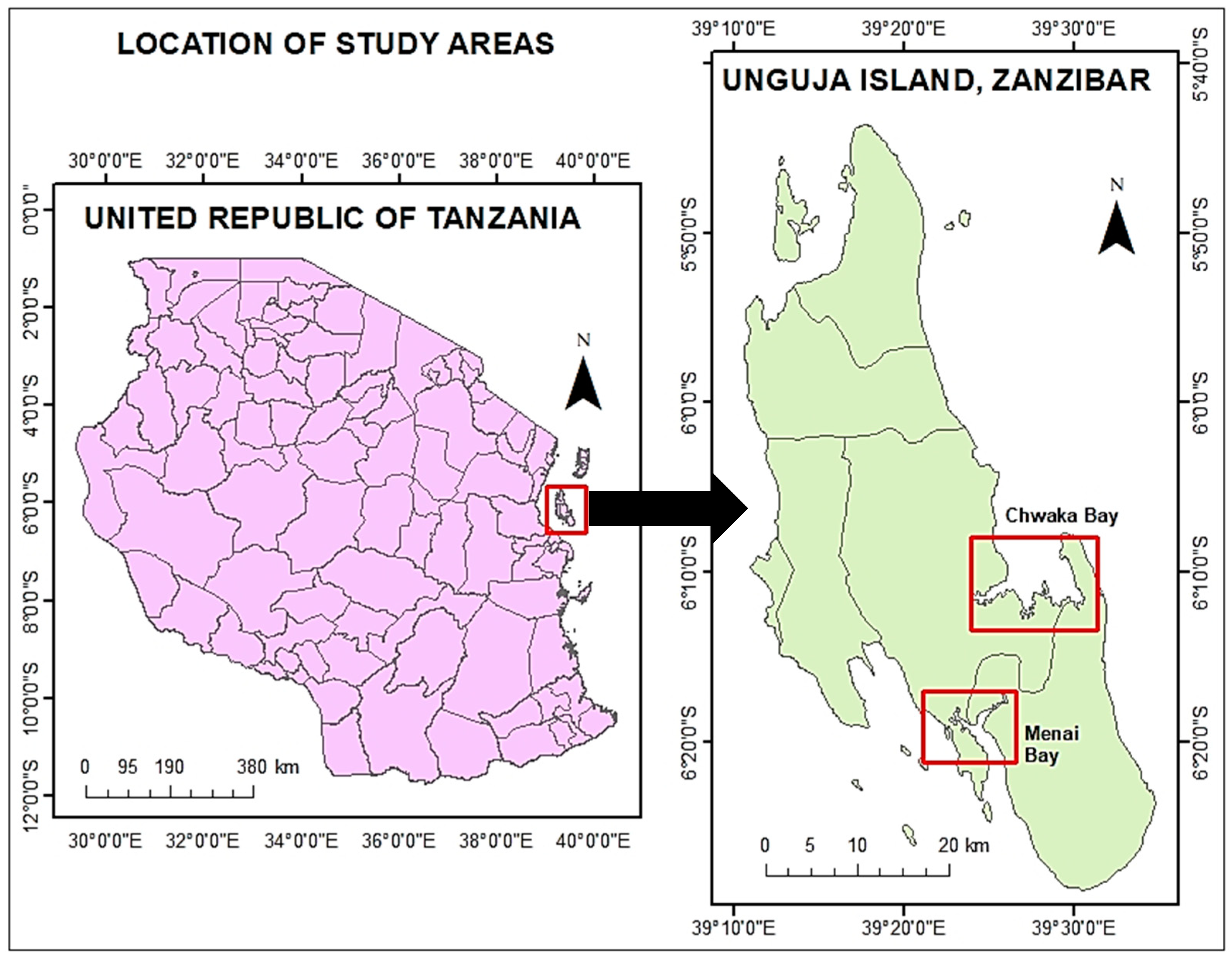

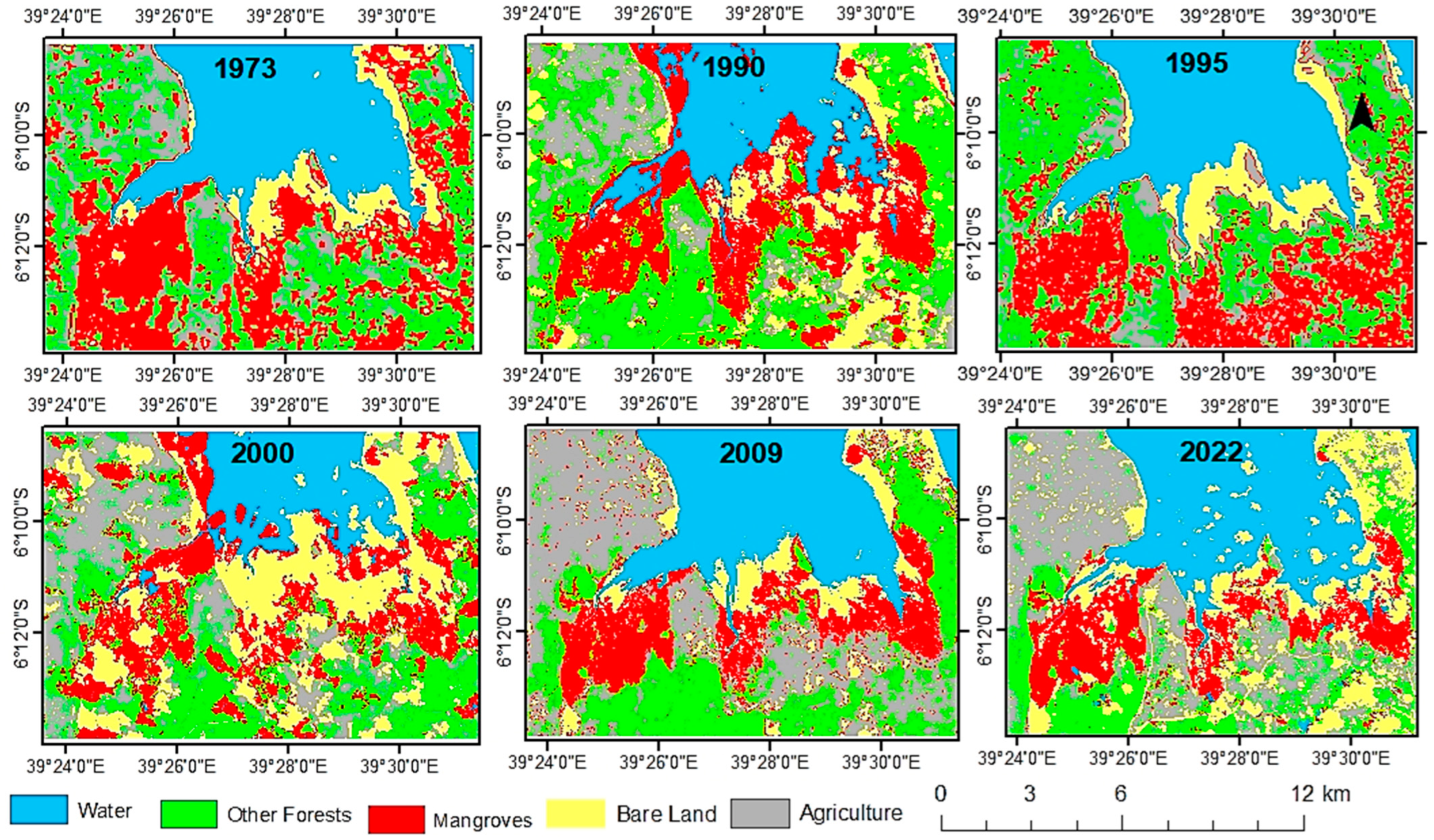
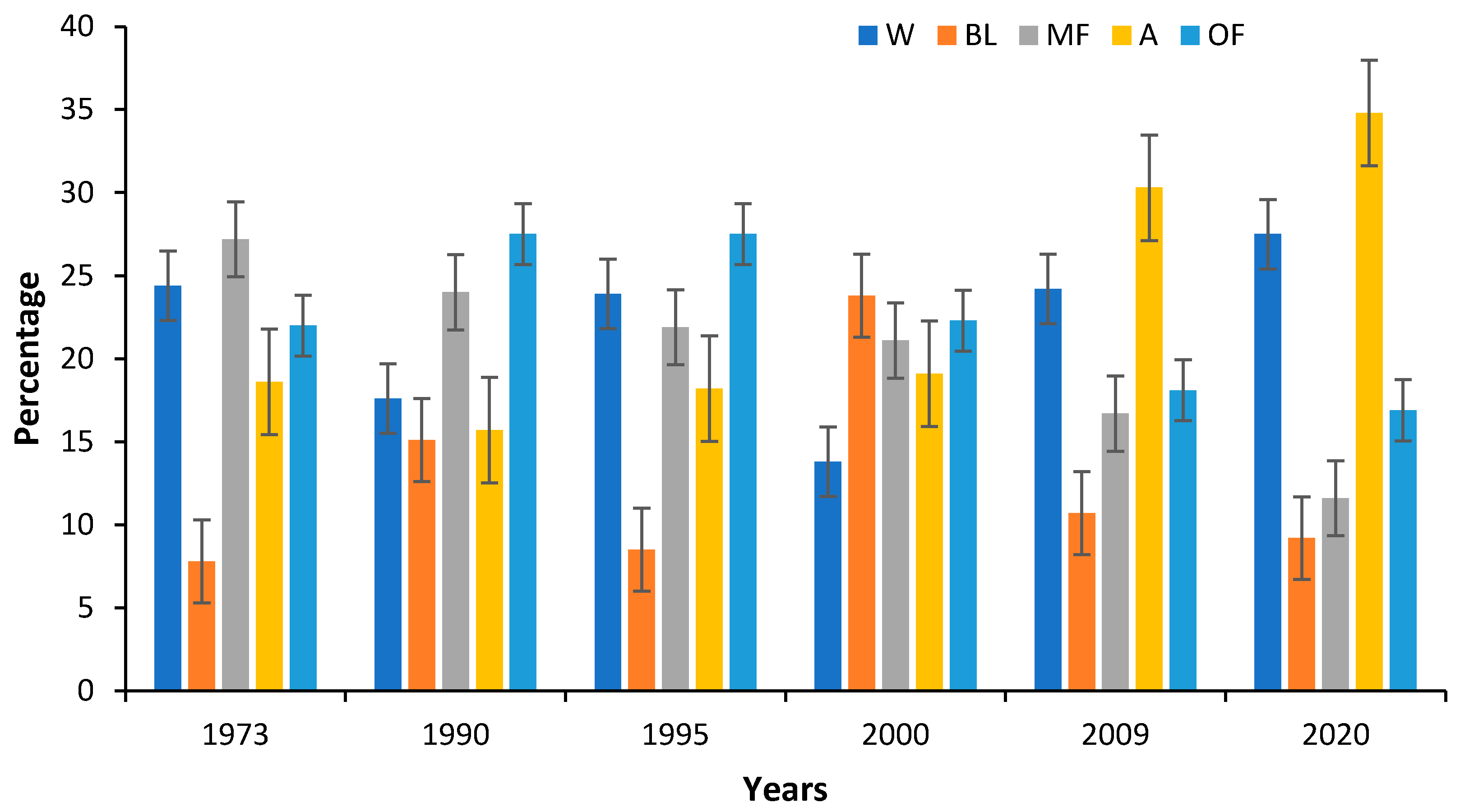


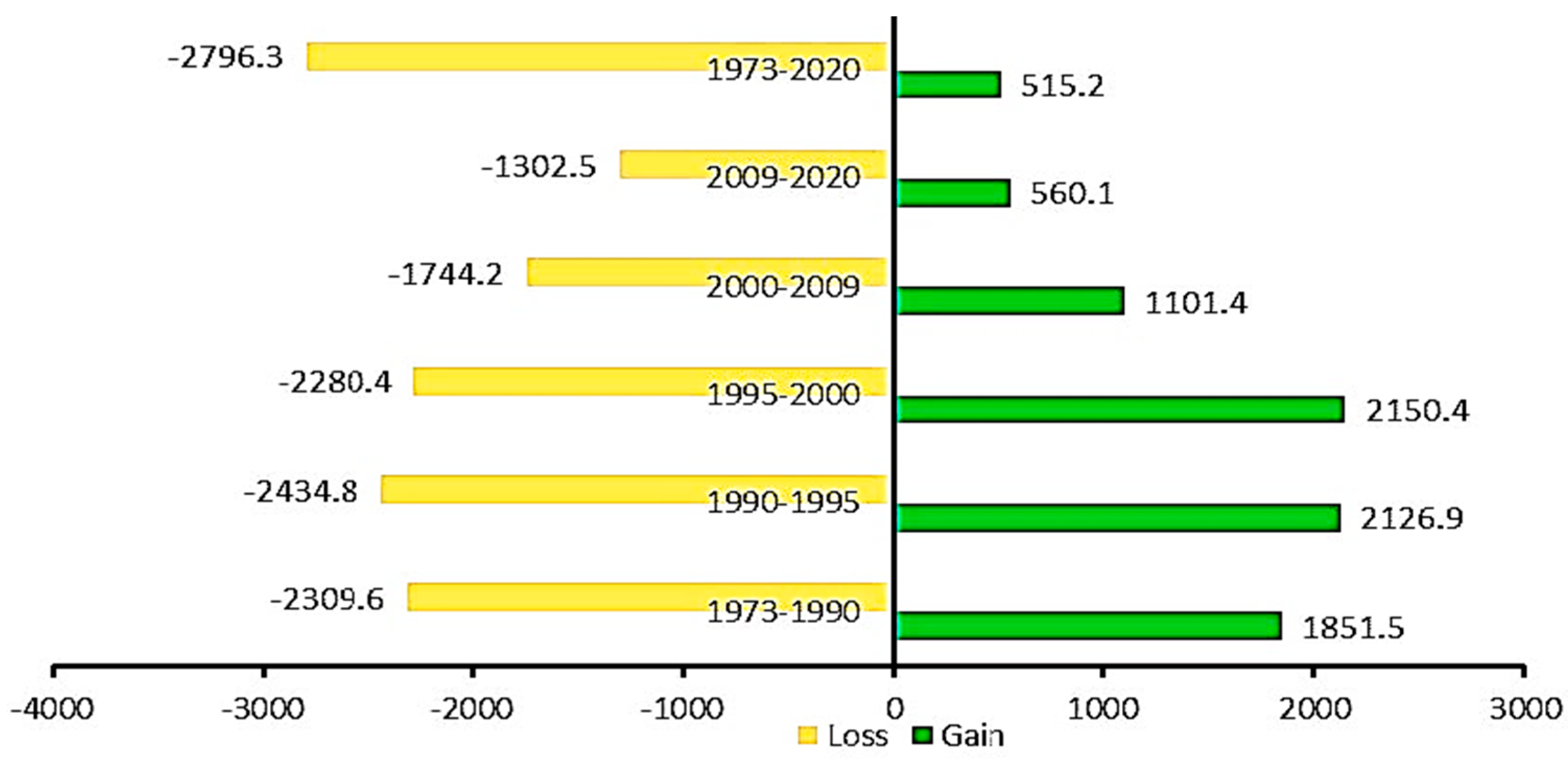


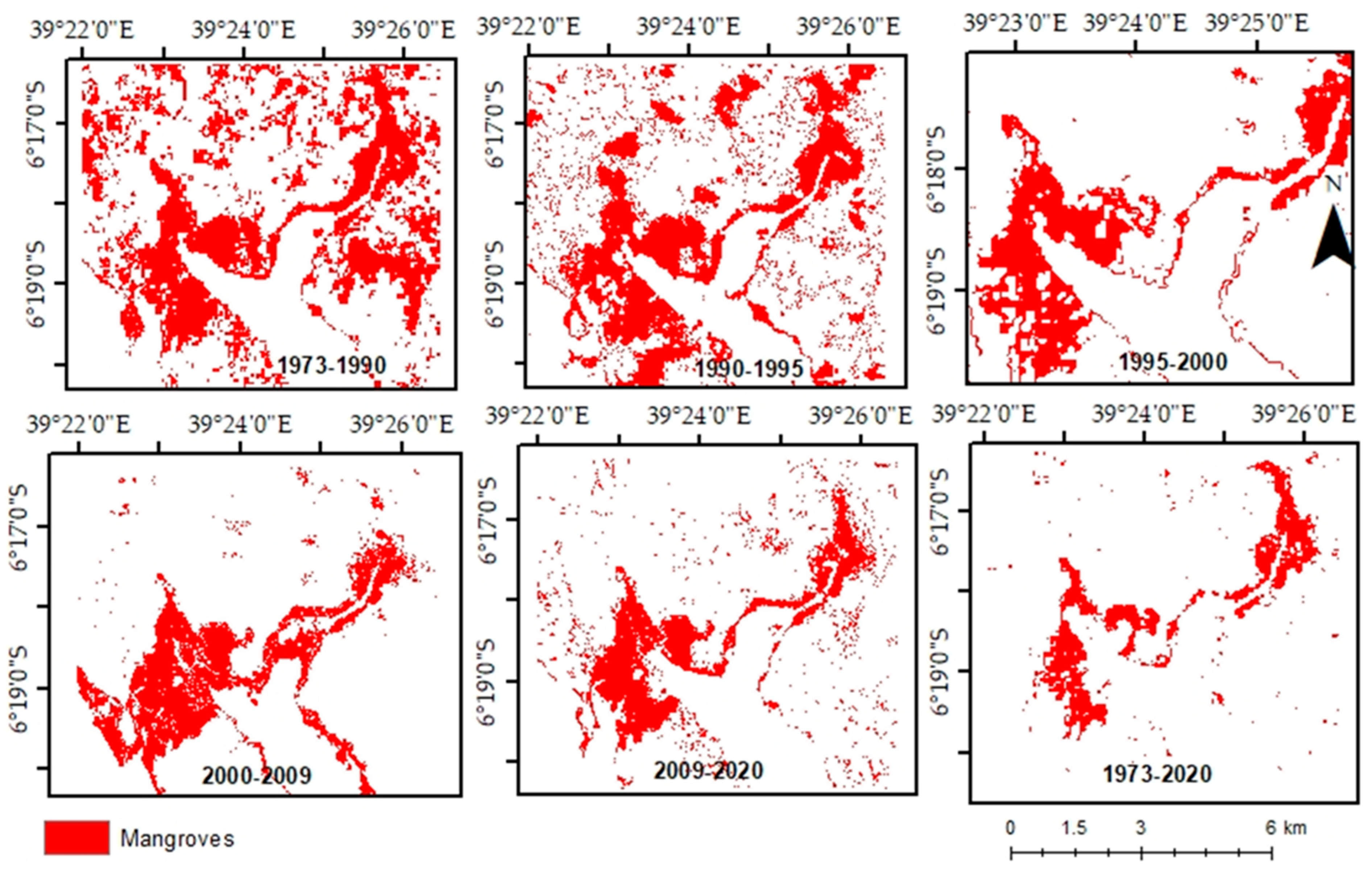
| Landsat | Google Earth | Topographical Maps | Aerial Data | |||||||
|---|---|---|---|---|---|---|---|---|---|---|
| Year | Bands | Landsat Type | Sensor | Resolution (m) | Year | Resolution (m) | Year | Scale | Year | Resolution (m) |
| 1973 | 1–4 | Landsat 1 | MSS | 60 | --- | --- | 1982 | 10,000 | 1975 | 5 |
| 1990 | 1–5, 7 | Landsat 5 | TM | 30 | --- | --- | 1990 | 1:9500 | 1991 | 5 |
| 1995 | 1–5, 7 | Landsat 5 | TM | 30 | --- | --- | 1996 | 1:7500 | 1996 | 3 |
| 2000 | 1–5, 7 | Landsat 7 | ETM+ | 30 | --- | --- | 2001 | 1:7500 | 2001 | 3 |
| 2009 | 1–5, 7 | Landsat 7 | ETM+ | 30 | 2010 | 0.3 | 2010 | 1:7500 | 2010 | 3 |
| 2020 | 1–7 | Landsat 8 | OLI | 30 | 2020 | 0.3 | 2020 | 1:2500 | 2017 | 0.5 |
| MSS (1973) | TM (1990) | TM (1995) | ETM+ (2000) | ETM+ (2009) | OLI (2020) | |||||||
|---|---|---|---|---|---|---|---|---|---|---|---|---|
| LULC Pairs | TD Index | J-M Distance | TD Index | J-M Distance | TD Index | J-M Distance | TD Index | J-M Distance | TD Index | J-M Distance | TD Index | J-M Distance |
| W/OF | 1.90 | 1.91 | 1.97 | 1.98 | 1.99 | 1.98 | 2.00 | 2.00 | 2.00 | 2.00 | 2.00 | 2.00 |
| W/MF | 1.93 | 1.93 | 1.97 | 1.97 | 2.00 | 2.00 | 2.00 | 2.00 | 2.00 | 2.00 | 2.00 | 2.00 |
| W/BL | 1.91 | 1.98 | 1.98 | 2.00 | 2.00 | 2.00 | 2.00 | 2.00 | 2.00 | 2.00 | 2.00 | 2.00 |
| W/A | 1.91 | 1.90 | 1.99 | 1.98 | 2.00 | 2.00 | 2.00 | 2.00 | 2.00 | 2.00 | 2.00 | 2.00 |
| OF/MF | 1.36 | 1.34 | 1.89 | 1.87 | 1.96 | 1.90 | 1.96 | 1.91 | 1.95 | 1.90 | 1.99 | 1.92 |
| OF/BL | 1.75 | 1.74 | 1.91 | 1.98 | 1.99 | 1.99 | 2.00 | 2.00 | 2.00 | 2.00 | 2.00 | 2.00 |
| OF/A | 1.50 | 1.45 | 1.89 | 1.90 | 1.90 | 1.89 | 1.92 | 1.83 | 1.92 | 1.83 | 1.94 | 1.85 |
| MF/BL | 1.88 | 1.85 | 1.89 | 1.87 | 1.99 | 2.00 | 2.00 | 2.00 | 1.99 | 2.00 | 2.00 | 2.00 |
| MF/A | 1.88 | 1.86 | 1.90 | 1.89 | 1.99 | 1.99 | 2.00 | 2.00 | 2.00 | 2.00 | 2.00 | 2.00 |
| BL/A | 1.84 | 1.82 | 1.83 | 1.80 | 1.97 | 1.92 | 1.98 | 1.97 | 1.98 | 1.97 | 1.98 | 1.98 |
| Band 1 | Band 2 | Band 3 | Band 4 | Band 5 | Band 6 | Band 7 | |
|---|---|---|---|---|---|---|---|
| Band 1 | ----- | 0.99 | 0.98 | 0.99 | 0.68 | 0.79 | 0.90 |
| Band 2 | ----- | 0.98 | 0.99 | 0.66 | 0.78 | 0.89 | |
| Band 3 | ----- | 0.99 | 0.78 | 0.87 | 0.92 | ||
| Band 4 | ----- | 0.71 | 0.82 | 0.93 | |||
| Band 5 | ----- | 0.96 | 0.87 | ||||
| Band 6 | ----- | 0.96 | |||||
| Band 7 | ----- |
| Chwaka Bay | Menai Bay | ||||||||
|---|---|---|---|---|---|---|---|---|---|
| Ground Data | Classification Results | Overall Accuracy | Kappa Coefficients | Ground Data | Classification Results | Overall Accuracy | Kappa Coefficients | ||
| 1973 | 160 | 142 | 82.5% | 0.72 | 1973 | 160 | 138 | 85.5% | 0.77 |
| 1990 | 160 | 136 | 85.4% | 0.76 | 1990 | 160 | 141 | 85.5% | 0.77 |
| 1995 | 160 | 136 | 86.6% | 0.79 | 1995 | 160 | 134 | 85.4% | 0.78 |
| 2000 | 160 | 146 | 89.3% | 0.81 | 2000 | 160 | 149 | 93.1% | 0.87 |
| 2009 | 160 | 139 | 91.7% | 0.86 | 2009 | 160 | 141 | 91.0% | 0.88 |
| 2020 | 160 | 153 | 92.7% | 0.89 | 2020 | 160 | 156 | 94.5% | 0.90 |
Disclaimer/Publisher’s Note: The statements, opinions and data contained in all publications are solely those of the individual author(s) and contributor(s) and not of MDPI and/or the editor(s). MDPI and/or the editor(s) disclaim responsibility for any injury to people or property resulting from any ideas, methods, instructions or products referred to in the content. |
© 2023 by the authors. Licensee MDPI, Basel, Switzerland. This article is an open access article distributed under the terms and conditions of the Creative Commons Attribution (CC BY) license (https://creativecommons.org/licenses/by/4.0/).
Share and Cite
Mohamed, M.K.; Adam, E.; Jackson, C.M. The Spatial and Temporal Distribution of Mangrove Forest Cover from 1973 to 2020 in Chwaka Bay and Menai Bay, Zanzibar. Appl. Sci. 2023, 13, 7962. https://doi.org/10.3390/app13137962
Mohamed MK, Adam E, Jackson CM. The Spatial and Temporal Distribution of Mangrove Forest Cover from 1973 to 2020 in Chwaka Bay and Menai Bay, Zanzibar. Applied Sciences. 2023; 13(13):7962. https://doi.org/10.3390/app13137962
Chicago/Turabian StyleMohamed, Mohamed Khalfan, Elhadi Adam, and Colbert M. Jackson. 2023. "The Spatial and Temporal Distribution of Mangrove Forest Cover from 1973 to 2020 in Chwaka Bay and Menai Bay, Zanzibar" Applied Sciences 13, no. 13: 7962. https://doi.org/10.3390/app13137962
APA StyleMohamed, M. K., Adam, E., & Jackson, C. M. (2023). The Spatial and Temporal Distribution of Mangrove Forest Cover from 1973 to 2020 in Chwaka Bay and Menai Bay, Zanzibar. Applied Sciences, 13(13), 7962. https://doi.org/10.3390/app13137962








